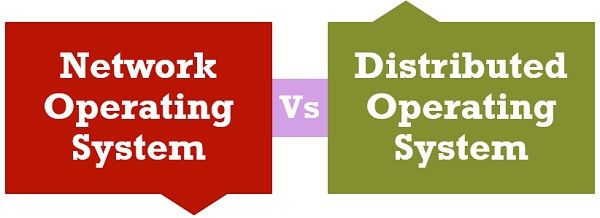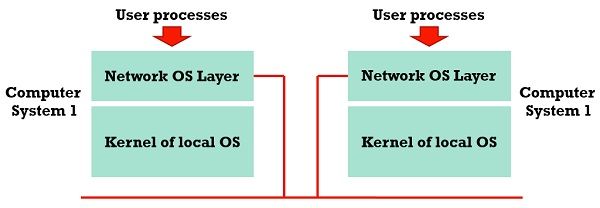 Network Operating System falls under the category of Distributed architectures where a large number of computer systems are connected with each other with the help of a network. Although the implementation of the network operating system is simpler than the distributed operating system. The network operating system and distributed operating system are distinguished by the characteristics they are having, such as the in network operating system each system runs its own operating system while the distributed operating system runs a global system-wide operating system.
Network Operating System falls under the category of Distributed architectures where a large number of computer systems are connected with each other with the help of a network. Although the implementation of the network operating system is simpler than the distributed operating system. The network operating system and distributed operating system are distinguished by the characteristics they are having, such as the in network operating system each system runs its own operating system while the distributed operating system runs a global system-wide operating system.
Content: Network Operating System Vs Distributed Operating System
Comparison Chart
| Basis for comparison | Network Operating System | Distributed Operating System |
|---|---|---|
| Objective | Provision of local services to the remote client. | Management of hardware resource. |
| Use | Loosely coupled system employed in heterogeneous computers. | Tightly coupled system used in multiprocessor and homogeneous computers. |
| Architecture | 2-tier client/server architecture. | N-tier client/server architecture. |
| Level of transparency | Low | High |
| Basis for communication | Files | Shared memory and messages |
| Resource Management | Handled at each node. | Global central or distributed management. |
| Ease of implementation | High | Low |
| Scalability | More | Less or moderate. |
| Openness | Open | Closed |
| Operating system on all nodes | Can be different | Same |
| Rate of autonomy | High | Low |
| Fault tolerance | Less | High |
Definition of Network operating system
The network operating system is the platform to run a system software on a server and allow the server to manage the users, data, groups, security, applications and other networking functions. It is considered as the primary form of an operating system for the distributed architecture. The idea behind the network operating system is to permit resource sharing among two or more computers operating under their own OSs. The functioning of the network operating system can be explained by the diagram depicted below. Here the network OS layer present between the kernel of the local OS and user processes. Essentially the processes interact with the network OS layer instead of the kernel of the local operating system. When the process demand for the non-local resources, the network OS layer communicates to the network OS layer of the node that contains the resource and employs the access to the resource by using it. On the other way, if the process request for the local resource, the network OS layer sends the request to the local OS kernel.
Here the network OS layer present between the kernel of the local OS and user processes. Essentially the processes interact with the network OS layer instead of the kernel of the local operating system. When the process demand for the non-local resources, the network OS layer communicates to the network OS layer of the node that contains the resource and employs the access to the resource by using it. On the other way, if the process request for the local resource, the network OS layer sends the request to the local OS kernel.
Unlike the distributed operating system, the network operating system does not work in a collaborated way. The local operating system residing in each particular computer preserves its identity which is visible to users too and behaves as a solitary operating system. In some implementations, there is a remote login for the remote operating systems to access the resources. A network operating system cannot control the utilisation of resources which causes the improper distribution of the resources. There is no provision of fault tolerance in the network operating system.
Definition of Distributed operating system
The distributed operating system handles a group of independent computers and makes them look like an ordinary centralised operating system. This is achieved by enabling the proper communication between the different computers connected with each other. The main aim of the distributed operating system is the transparency where the use of multiple hardware resources is hidden from the users. The distributed operating system is less autonomous than network operating system as the system has complete control in this environment. It dynamically allocates processes to the random CPU and the files storage is also managed by the operating system which means that the user would not know which hardware has been used for the processing of its computation and for storing its file.
As it is mentioned above the distributed operating system allows resource sharing in which an application can use resources located in any computer system. It provides the availability (continuity of the services) rather than faults. A distributed operating system handles the operation of all nodes in the system in an integrated way since each node has its separate kernel to perform control functions on its behalf. It also increases the computational speed by executing the parts of computation in different computer systems.
Key Differences Between Network operating system and Distributed operating system
- The main goal of the network operating system is to provide local services to the remote client. On the other hand, the objective of the distributed operating system is to provide the hardware resource management.
- Network operating systems are said to be loosely coupled systems and are used in heterogeneous computers. As against, distributed operating system is considered as tightly coupled systems mainly used in multiprocessors or homogeneous computers.
- The network operating system has two-tier client/server architecture, while n-tier architecture is employed in the distributed operating system.
- Transparency in the network operating system is low. Conversely, the distributed operating system has high transparency, and it hides the resource utilisation.
- In the distributed operating system the communication between the computers (nodes) is achieved by shared memory or sending messages. On the contrary, the network operating system sends files in order to communicate with other nodes.
- Network operating system manages resources at each node while in the distributed operating system, the resources are globally managed whether it is centred or distributed.
- The network operating system is easily implemented as compared to the distributed operating system.
- Scalability of the network operating system is higher than the distributed operating system, and also it is more open to the user.
- In network operating system the operating system installed in the computers can vary whereas it is not the case in the distributed operating system.
- The network operating system is more autonomous than the distributed operating system. In contrast, the distributed operating system is more fault tolerant.
Conclusion
The prior difference between network operating system and distributed operating system lies within their implementation wherein network operating system there is no modification or changes are applied to the core system while in the distributed operating system the system components can be subjected to upgradation if required.
rubix982 says
Thank you! Pretty clear explanation